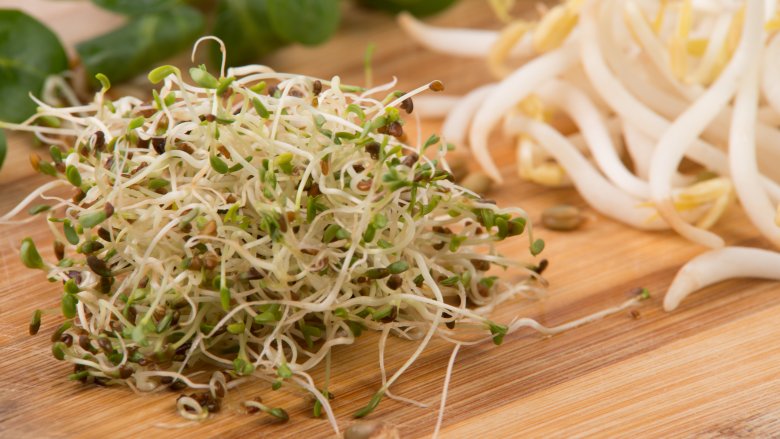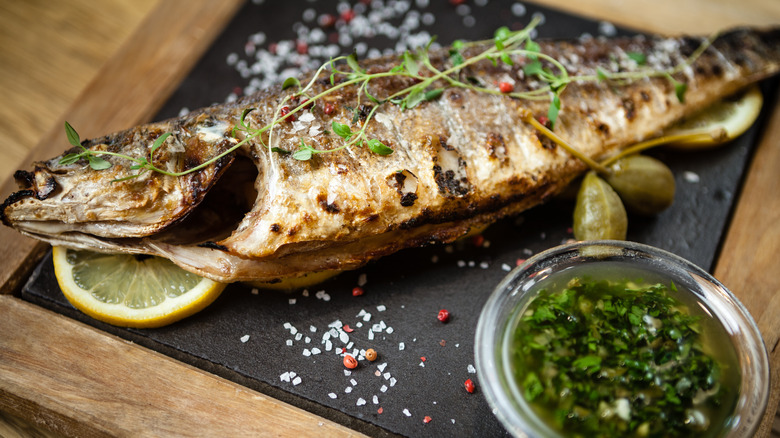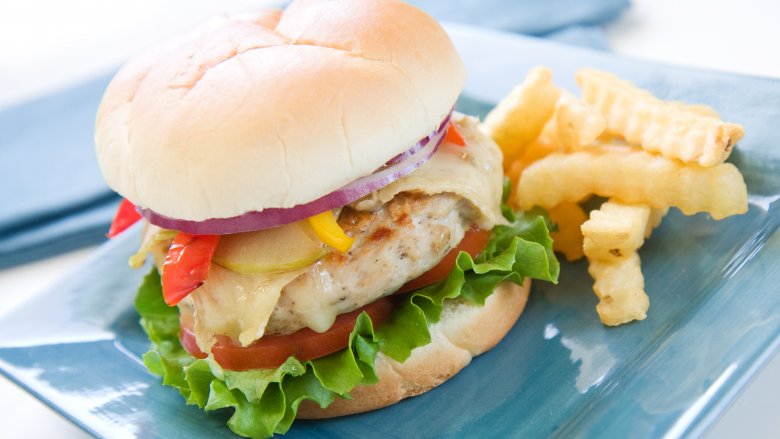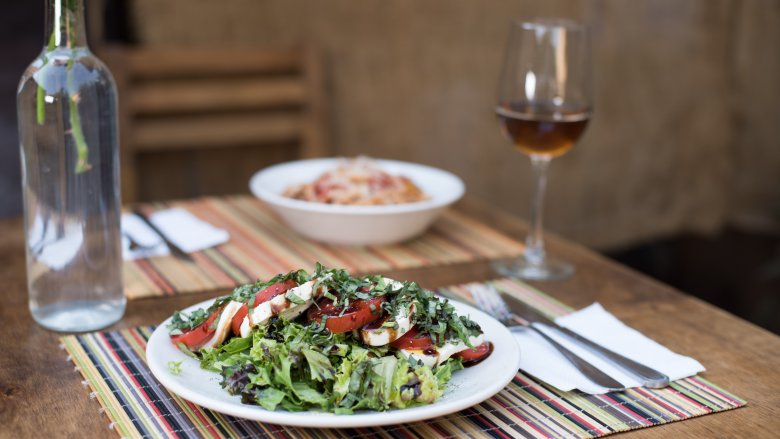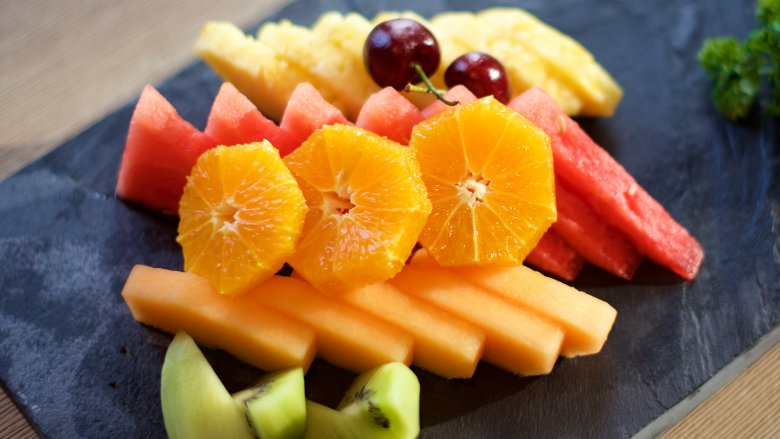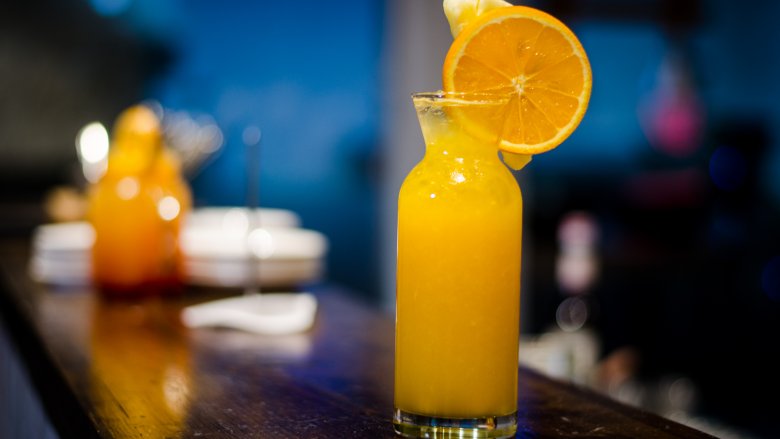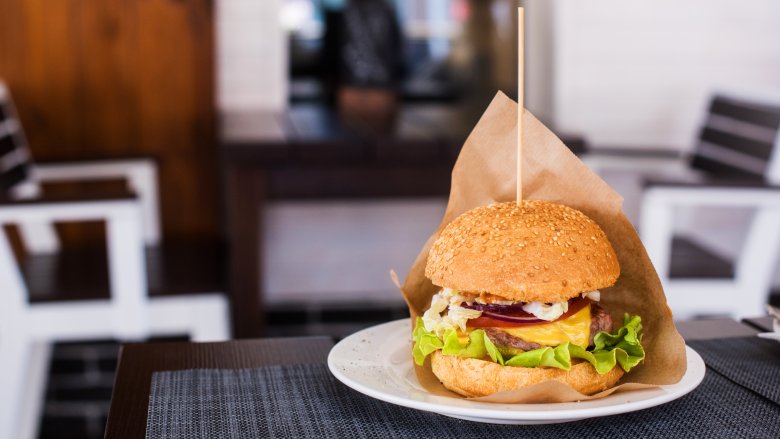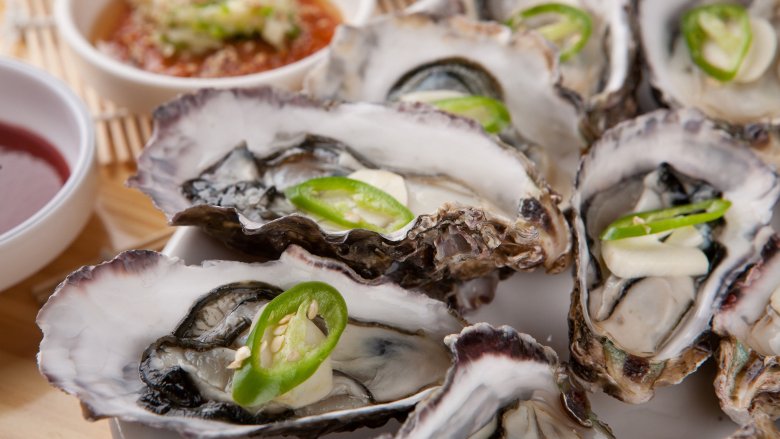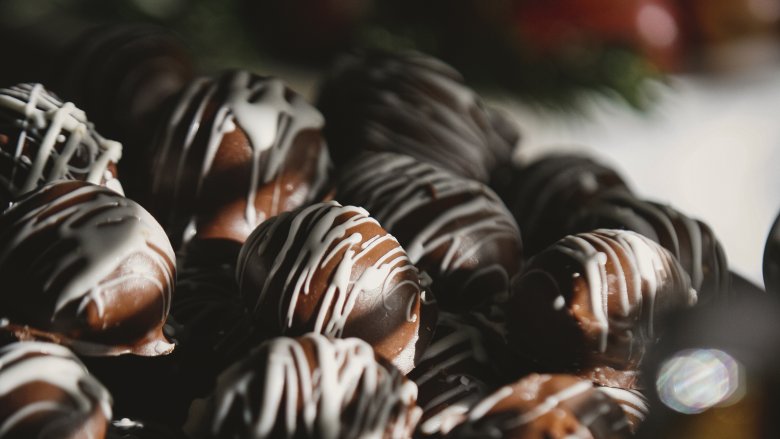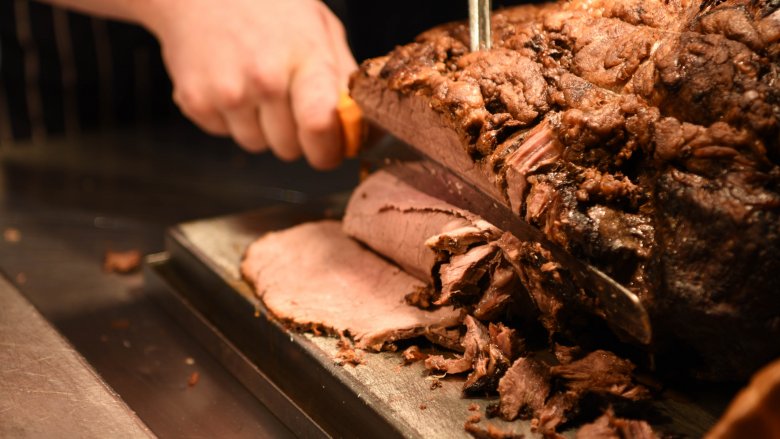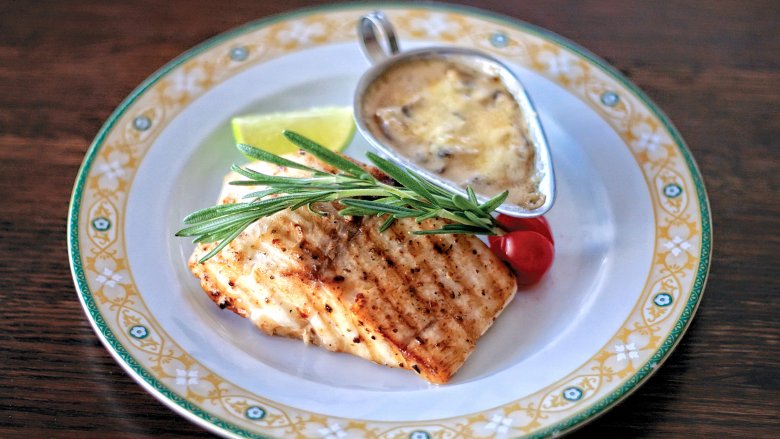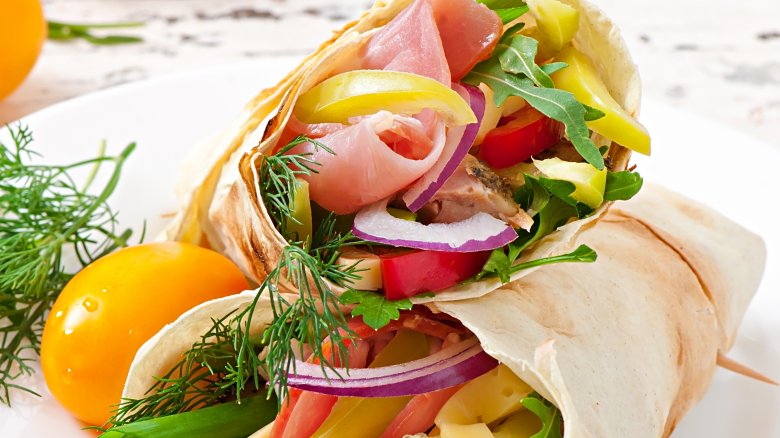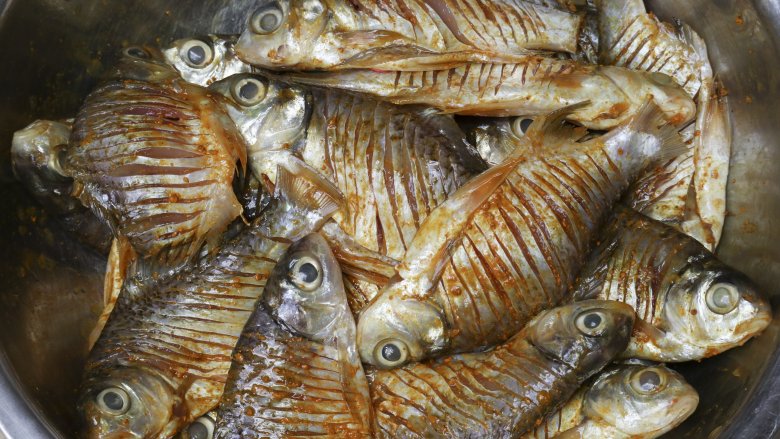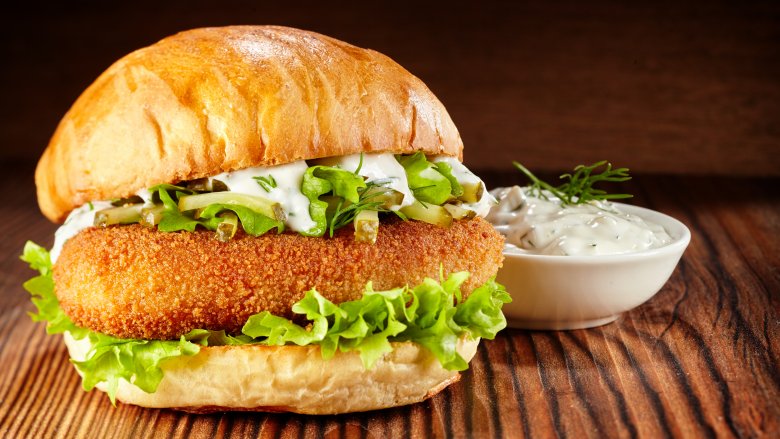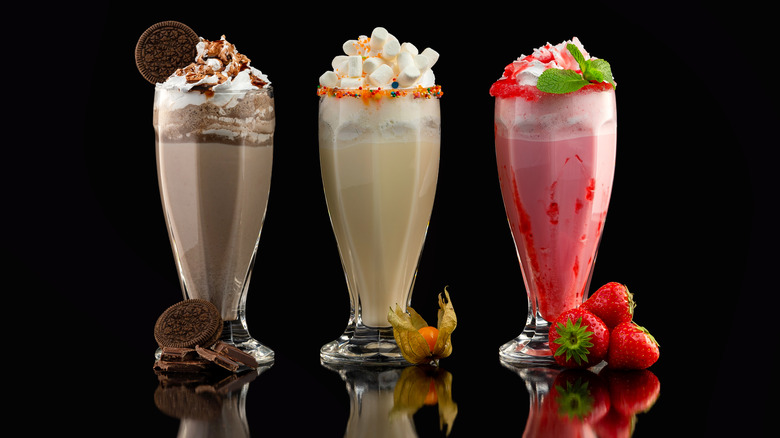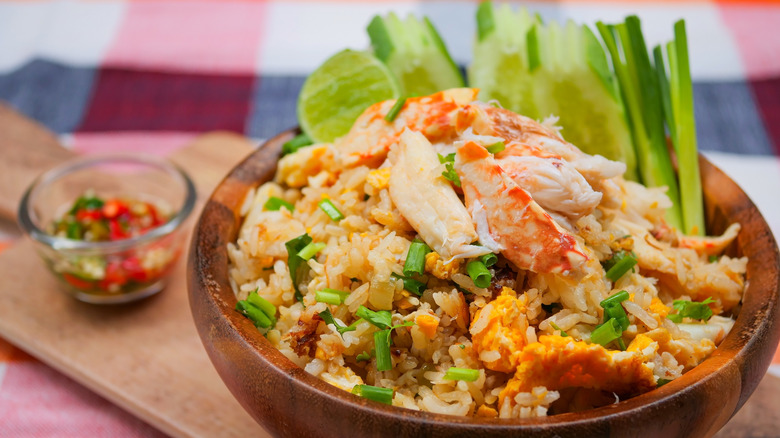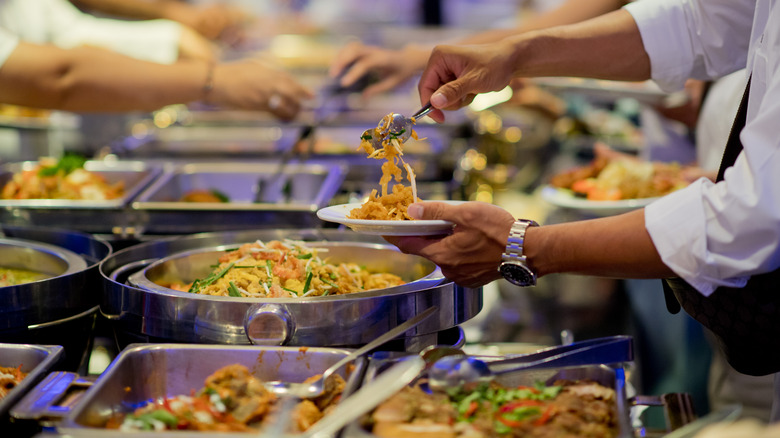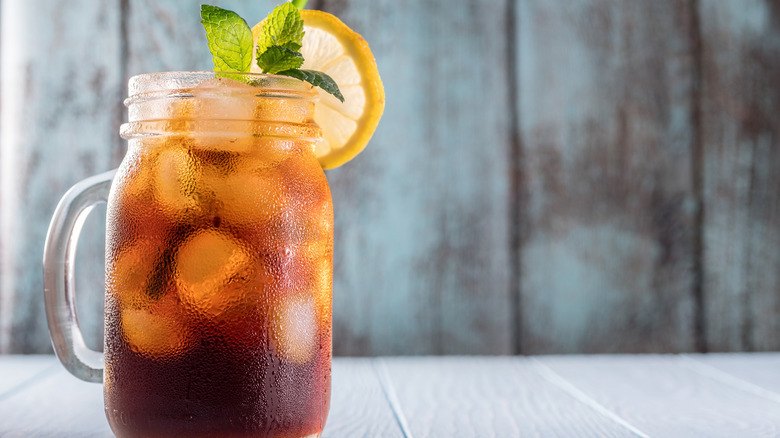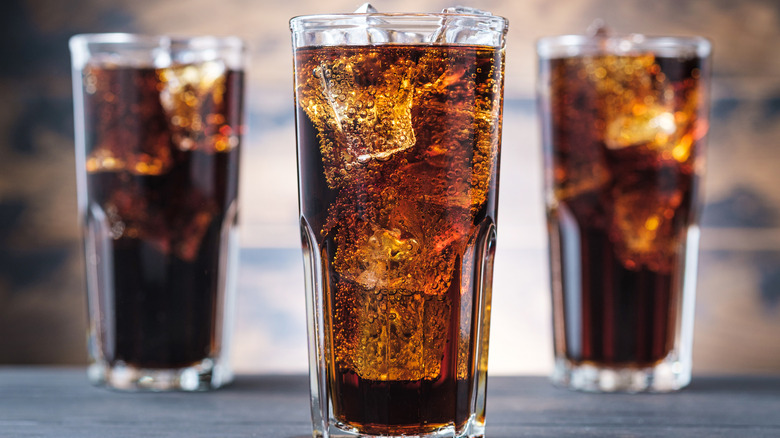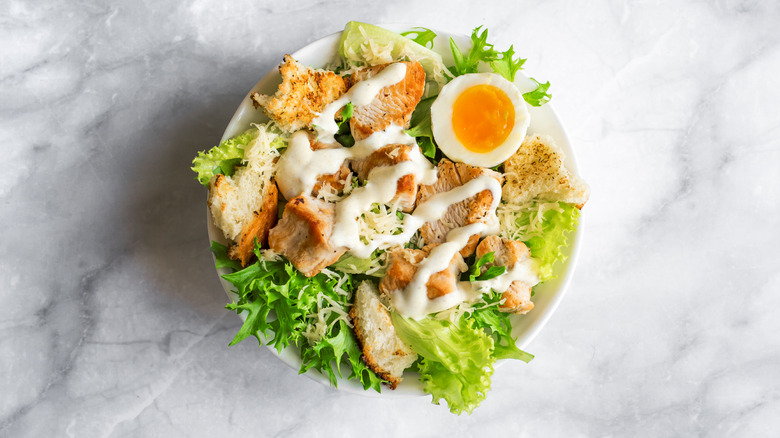These Restaurant Foods Are Most Likely To Cause Food Poisoning
Nothing will ruin your evening — and week — like a bout of food poisoning. You know all kinds of ways to steer clear of food poisoning in your home, like getting rid of your cracked dishes instead of trying to get one more use out of them, and being cautious of cross-contamination while you cook. But what about when you're eating out? You're putting a lot of trust in what goes on in a kitchen, and while there are sure signs something's not right (like dirty bathrooms and utensils that haven't been washed), that doesn't cover all your potential pitfalls. Are some menu choices more likely to leave you running for the bathroom?
Absolutely, and sometimes, food poisoning just happens. Some foods are definitely more prone to make you sick and sometimes, it's through no fault of the restaurant. It might be how you order something prepared, or it might be contaminated from the source. So, if you have a big night out planned, a meeting in the morning, or a fun weekend you're looking forward to, what should you skip to help make sure you're not going to ruin it?
Anything with sprouts
Jimmy John's made headlines when several people got sick from eating there in late 2017, and according to SF Gate, the Illinois Department of Health determined the culprit was alfalfa sprouts. They were asked to stop serving them, and immediately took them off the menu in all their locations nationwide.
Do a little more digging, and you'll find sprouts — even those you might grow at home — are incredibly risky. According to FoodSafety.gov, sprouts have been responsible for as many as 30 outbreaks of food poisoning since 1996. Protocols were put in place in 1999 to try to regulate the safety of sprouts that made it to market, but there's still no real solution to a problem that starts right from seed. Sprouts need to be grown in warm, damp conditions, and those are the same conditions that bacteria like Salmonella and E. coli thrive in. Since most sprouts are served raw or only lightly cooked, that means they're the perfect vehicle for delivering a serious bout of food poisoning.
Warm-water, reef-dwelling fish
First, what are we talking about when we say warm-water, reef-dwelling fish? We're talking about fish that come from areas like the Mediterranean, Caribbean, and the Gulf of Mexico, and particularly carnivorous fish that live in coral reefs. Those are things like grouper, barracuda, sea bass, sturgeon, and moray eel, and you should avoid these because according to the Centers for Disease Control and Prevention, these are the types of fish most likely to cause ciguatera fish poisoning.
It's a huge deal, and it's caused by the presence of G. toxicus in coral reefs. They're first eaten by small fish, and as they move up the food chain they become more and more concentrated until they finally get to the top: us. Around 50,000 people a year experience this terrifying type of food poisoning, with symptoms that include the usual gastrointestinal distress but also fatigue and insomnia, weakness, acute sensitivity to hot and cold, and even a sensation some of your teeth are loose. Some of these neurological symptoms can last for years, so next time you're on vacation, skip the sea bass.
Ground turkey burgers
Turkey burgers might seem like a healthier alternative to a beef burger, but Consumer Reports issued a terrifying warning in 2013 after they did an extensive study of ground turkey samples. An overwhelming majority of samples — as much as 69 percent — tested positive for enterococcus. That's bad, and even worse, only slightly fewer samples — 60 percent — were positive for E. coli.
It gets even worse for turkey-lovers, too. The majority of the bacterial strains found in ground turkey were also resistant to the antibiotics typically used to treat them. That's in large part due to the prevalence of using antibiotics in farm-raised turkeys, and it also means that if you do get sick from eating ground turkey, it might take a long, long time and several different antibiotics before you find one that's actually going to help you get better.
They also say there are no laws being broken here, and the USDA permits a certain amount of salmonella and other bacteria to be present in raw turkey samples. The rationale says that the bacteria will be cooked away, but if you want to be on the safe side, just give this one a miss.
The salad (and raw vegetables in general)
In 2018, dozens of people from states all across the US fell ill to food poisoning linked to romaine lettuce. The CDC issued regular updates, and recommended people stay away from romaine until the outbreak was deemed to be over, particularly avoiding lettuce grown in Arizona.
Unfortunately, food poisoning from leafy greens and raw vegetables is nothing new. Bill Marler is an attorney who specializes in food safety law, and when he talked to the Miami New Times about some of the dangers facing consumers in the 21st century, he pointed to leafy greens as one of the biggest. They're often exposed to bacteria in the growing and processing steps, but since they're not cooked, they don't go through what he calls a "kill step".
Marler says the problem is compounded when you eat out. While you might be careful about washing greens at home, restaurants typically use pre-washed or bagged greens. Any bit of bacteria still left on them will grow in the fridge, so he recommends skipping the salad and ordering a side of cooked veggies for a starter.
The fruit plate (especially if there's melon)
There's not much on the menu that might seem like a healthier option than the fruit plate, but according to food safety attorney Bill Marler, that fruit — and particularly, cantaloupe — is high on the list of foods you should avoid (via the Miami New Times).
Between 1990 and 2012, at least 36 food poisoning outbreaks, more than 500 individual cases, and two deaths were traced back to cantaloupe. The Huffington Post took a look at why cantaloupe was so prolific when it came to the spread of bacteria, and there are a few things at work. Bacteria can pass through the cantaloupe's thick skin, and the rough texture of that skin traps it once it's there. They also grow on the ground, and that can put their strange skin in direct contact with bacteria-filled dirt and water, which sometimes contain animal waste-based fertilizers. There's also the potential for bacteria to get in through the melon's stem scar and together, that means there's a ton of potential for illness-causing bacteria to seep into melons. It turns out that fruit plate might not be so good for you after all.
Raw or unpasteurized milk or juice
We've talked a bit about how the weird trend of raw water can be pretty dangerous, and the same goes for the raw or unpasteurized products you might see on the menus of your favorite cafe or bistro. Everyone loves the idea of eating locally sourced food and supporting farmers right in your own neighborhood, and there's nothing wrong with that. But according to food safety attorney Bill Marler (via the Miami New Times), ordering fresh, raw, and unpasteurized milk can be a huge problem.
He's seen dozens and dozens of people fall ill because of the bacteria not just in unpasteurized milk, but in raw fruit juice and cider, too. He adds that even small, organic farms can be the source for this kind of food poisoning, and according to British Columbia's HealthLink BC, there were around 1,700 cases of this kind of food poisoning reported between 2000 and 2010 (in all of North America). Juice from apples, oranges, lemons, pineapple, coconut, and bananas have all been culprits, and most instances involve children, E coli., and Salmonella. Contamination occurs when the juice is squeezed, and they say that refrigeration absolutely won't kill bacteria — only pasteurization will, so go ahead and skip that raw juice option.
Less than well-done burgers
In 2017, the British-Irish food safety and nutritional awareness group Safefood kicked off a campaign called Burger Fever, partially in response to the growing trend of restaurants selling boutique and gourmet burgers cooked rare or medium. They stressed the importance of not ordering a burger that's anything but well-done, because undercooked burgers carry a higher risk of both salmonella and E.coli.
They also address why rare burgers are way more likely to make you sick than, say, a steak, and it has to do with preparation. Bacteria start out only on the surface of the meat, so when you order a steak, they're seared off on the outside while the inside can stay pink. Burgers are minced, though, and that spreads the bacteria throughout the patty. Any pink in the center means bacteria can still live there, and the only way to guarantee you're not going to get sick is to order a well-done burger, and cut it in half to check it's cooked through before you dig in.
Raw oysters
It doesn't matter where you're eating or how clean and careful a restaurant is, opting for raw oysters is always going to put you at risk of food poisoning. That's because most oysters come from waters that are also home to a bacteria called Vibrio, and FoodSafety.gov says it's very, very likely oysters are exposed. Around 80,000 people a year get sick from vibriosis and an average of 100 people die from it, so it's definitely something you don't want to mess with.
The CDC also says you can't see, smell, or taste contamination, and that it can happen any time of the year and in any temperature of water. Fully cooking oysters is the only way to make sure any of this potentially devastating bacteria is killed, and this stuff is no joke. While some people only get the typical symptoms of food poisoning, extreme cases can result in skin lesions and might even mean limb amputations. They also add that no, alcohol and lemon juice isn't going to kill Vibrio, either, and seafood safety is just good common sense.
Truffles and other no-bake desserts
Let's be honest here and admit that sometimes, the cookie dough tastes better than the actual cookies. Eating it is something of a no-no, though, and you've probably heard that's because of the eggs. There's another problem here that we talk about less, and it's also the reason you should skip truffles and other no-bake desserts that you might find on your favorite restaurant's menu.
The Centers for Disease Control and Prevention say flour is just as problematic when it comes to potential dangers, and that's because it's essentially a raw, agricultural product that hasn't been treated to remove any potentially harmful organisms. Bacteria like E. coli are known to make it into the flour during the growing or milling processes, and while they're killed during the cooking process, that means you should give desserts that haven't been baked a miss.
That includes things like truffles, and ice cream or milkshakes made with raw cookie dough, brownie batter, or cake mix. It's a sneaky, often-overlooked source of food poisoning, but it's not uncommon and made dozens of people — across dozens of states — sick in 2016.
Carvery/roast beef
Sure, the best part of a buffet might be the carvery, but you might want to rethink asking someone to slice off a big hunk of roast beef for you. The CDC names large roasts as one of the most common sources for C. perfringens, a type of bacteria that causes somewhere around a million cases of food poisoning each and every year.
Why roasts? There are a few reasons, and the first is that this particular type of bacteria prefers oxygen-free environments, like the middle of a giant hunk of meat. Because roasts are usually prepped and cooked in advance of a meal service then kept warm before and during the meal, they're the perfect environment for this bacteria.
Strangely, some people normally have C. perfringens living in their intestines. Problems really start to happen when it's ingested, though, because it multiplies incredibly quickly and in high numbers can cause not just food poisoning, but complications like severe dehydration.
Escolar and oilfish
If you've never heard of escolar, chances are pretty good you'll soon see it popping up at fishmongers and in restaurants. It's becoming more and more widely fished as an alternative to other kinds of fish — particularly those susceptible to over-fishing — and it seems like that would be a good thing. There's a catch, though, and that's the food poisoning-like symptoms that people suffer from after eating it.
Escolar (which is also called butterfish and oilfish) has a diet heavy in wax esters. That's the stuff that gives it a particularly delicious texture, but it's also the stuff that causes some major gastrointestinal distress when people eat it. Since we can't digest the oils, we've got to get rid of it some other way. That's through what the Government of South Australia's Department for Health calls, "...the sudden onset of watery and oily diarrhea". According to The Kitchn, it's so bad that the fish is banned in Italy and Japan, and it comes with a warning label in other countries. Yikes.
Sandwiches or wraps with uncooked meats and veggies
You've heard of staph, and it's actually normally found in about a quarter of perfectly healthy people and animals. And that's the problem — all those people and animals are carriers, and the CDC says they can contaminate food in the process of preparation.
That's why deli sandwiches and wraps with sliced meats are on the list of things you should probably avoid when you're heading out to grab lunch at a restaurant. The CDC describes the perfect vehicle for Staph as uncooked foods directly handled by people, and sliced meats are at the top of the list. There's no outward signs there's anything wrong with the food, and if you do happen to get it, antibiotics aren't going to help you.
If you're still determined to get that fresh-sliced deli sandwich, do yourself a favor and at least pass on the ham and other cold cuts with high sodium content. Staph thrives in salt-rich environments, and that makes sliced ham pretty much paradise.
Fermented Alaskan foods, especially seafood
Fermentation is a natural process that a lot of our foods go through. From sauerkraut to beer, you've undoubtedly opted for ordering fermented foods or drinks off the menu, but according to the CDC, there's one category you should probably avoid: Alaskan fermented foods.
Those are things like fermented, dried, and salted fish, along with other traditional Alaskan foods. While you might never expect to see things like fermented whale, fermented fish eggs, and fermented seal on a menu, they're not just traditional Alaskan delicacies, but they're also responsible for helping make Alaska a leader with a dubious honor: the state with the most cases of botulism in the US. It's no joke, either — the Alaska Division of Public Health warns that the toxins released into someone's body during a case of botulism act as a paralytic, and can stop all internal functions, and it's almost always linked to traditional foods.
So, when you're thinking about heading off on that Alaskan cruise, do so. But be wary of sampling any fermented foods, or you might just miss the best parts of your trip.
Anything with restaurant-prepared mayo
Restaurants tend to be proud of their specially-prepared sauces, seasonings, rubs, and dips. While you should absolutely opt in when it comes to things like signature BBQ sauce, you might want to rethink restaurant-made mayo.
Australia's Good Food warns of the dangers, and says it's played a fairly large part in the cases of salmonella they've seen in recent years. In 2015, one woman died after eating mayo prepared with raw eggs, and the Victorian Department of Health reported dozens and dozens of others have suffered from effects of severe food poisoning after eating mayo prepared in-house at a cafe using free-range eggs. Even though they say the country typically has a low incidence of salmonella-contaminated eggs, it's absolutely not worth the risk. Mayo-related outbreaks have happened in other places, too, like a 1996 outbreak in Saudi Arabia. While it might be tempting — and easy to forget that there are raw eggs in mayo — it might not be worth the risk.
Soft serve ice cream and milkshakes
Even those among us who can't look at a Big Mac without cringing might swing through the drive-thru at McDonald's for the occasional soft serve ice cream cone, and it's no wonder why: they're delicious. But according to Public Health Insider, soft serve and milkshakes have been linked to numerous reports of food poisoning — and not just at McDonald's. In 2015, health experts were investigating a few cases of food poisoning that were ultimately linked to milkshakes served at the University of Washington Medical Center. Go back a few years, and you'll find instances like a 2004 outbreak where more than 120 people got so severely sick that according to NBC News, local law enforcement originally suspected there had been a bioterrorism incident. Some suffered kidney failure, while others needed to be carried out of their homes to waiting ambulances.
So, what's going on here? There's a few things that make restaurant ice cream potentially dangerous, says Taste of Home, and that starts with the fact that some commercially-produced ice creams still include raw eggs, which can contain salmonella. There's also a chance for contamination when ice cream melts a bit, and improperly cleaned utensils are used to prep the dessert dish.
Improperly cleaned or even malfunctioning soft serve machines are an even bigger risk. The health department involved in that massive McDonald's outbreak blamed (in part) a "mechanical malfunction" of the machine, which led to the staphylococcus contamination.
Rice (especially egg fried rice)
The next time you hit the Chinese buffet or order from the local takeout restaurant, there's a good reason to think twice about the rice — and definitely think twice about the egg fried rice, especially if it's not prepared to order. Fried rice is so commonly a culprit in food poisoning cases that it's even given the name "fried rice syndrome" to the type of food poisoning caused by the bacteria Bacillus cereus. LiveScience says that while most cases are mild, there are more than 63,000 of those cases each and every year — and most have been traced back to rice.
The problem happens when rice is cooked and then left at improper temperature. It only takes a few hours for the growth of illness-causing B. cereus to start, and health experts warn that reheating rice doesn't kill the bacteria that's already started to grow. Additionally, USA Today says that since restaurants often prepare large quantities of rice for, say, an evening meal, there's a definite chance it's going to cool into the danger zone before it's served. Bottom line? Not only should you not reheat that container of fried rice you only got halfway through last night, but you might want to skip the rice completely.
That buffet food
It's no secret that some buffets can be pretty amazing. Where else can you get a plate full of shrimp and crab, topped with a pulled pork sandwich, some cornbread, and a hot dog? But here's the thing: Experts — like Johns Hopkins School of Medicine professor of infectious diseases Allison Agwu — say (via Vice) that because buffets are exposed to all kinds of people and their germs, it's pretty much science soup. Think of it this way: Buffets are usually the reason entire cruise ships become floating diarrhea wards, so how is that a lot different than the buffet down the street?
"But," you might say, "I've never gotten sick after eating at a buffet!" Congratulations! You might be in a minority. Agwu says there's a wide variety of invisible nastiness that can be lurking on buffets, and adds that salmonella, listeria, norovirus, Adenovirus, and E. coli have all been linked to food poisoning outbreaks traced back to buffets. "Buffets, when they are done right, are great," she explained. But unfortunately, she also says that rarely happens — in large part because of other customers that need to observe proper procedures to minimize cross-contamination, while not doing things like licking utensils and fingers before sticking them into communal food and, of course, sneezing. People being people, Agwu adds: "Buffets can be a cesspool for bacteria and viruses."
Lemons and limes in your drink
While it might seem like you're making a responsible choice when you pick water or iced tea with a slice of lemon over a sugary soda, there might be a massive catch. In 2019, published research from the University of Florida's Institute of Food and Agricultural Sciences looked at just how likely salmonella was to survive on the surface of a lemon or lime that was then dunked in your drink, or put on the side of a glass. They found that yes, lemons and limes contaminated by improper handling can definitely transfer bacteria into your drink, and ultimately lead to a nasty case of food poisoning.
Additionally, researchers also say that there's something else to consider here, too. In many places, it's servers, wait staff, and bartenders who are making the drinks, and unless they're really, really, really careful, there's a higher risk that they're going to be transferring some unwanted hitchhikers onto those garnishes. Unless they're washing their hands pretty faithfully, it's the nature of the job.
Think asking for a squirt of lemon juice might be safer? It's possible, but it's also worth noting that according to LiveStrong, lemon juice that's gone past the expiration date can turn sour, and contain all kinds of bacteria that will make you just as sick.
Ice in your drink
It's perhaps the easiest decision you have to make every time you go out to eat. Getting a drink is pretty straightforward and standard, but it turns out that there might be something dangerous lurking in that drink. Specifically, it's on the ice.
Debra Huffman is a University of South Florida microbiologist who told NBC News that it isn't the ice itself, it's how many restaurants handle it. If you've ever seen a restaurant employee fill a glass of ice by just reaching in and scooping it with a cup or glass, you should know that's a big mistake that can transfer germs into the ice — and they can definitely survive to make it into your drink. (Easy Ice adds that breaking a glass in the ice is another massive danger, especially given that broken glass and ice can look the same.)
Even if the proper scoop is used, there's still a danger; it comes from servers who might handle anything from money to other customers' used dishes and silverware before grabbing a scoop, getting some ice, then stowing it back in the ice — that's just a bacterial transfer waiting to happen, too. Storing the scoop outside of the bucket and making sure the handle never comes in contact with the ice is the only safe way to do it, but when NBC's hidden cameras visited 20 different restaurants, only one observed proper procedures. That's some food for thought.
Caesar salad/dressing
Who doesn't love a nice Caesar salad? Sadly, it's entirely possible that the salad might not love you back, and we're not just talking about the fat and calories in that dressing. It turns out that there might be something else hiding in there, and it's salmonella.
The problem, says the Centers for Disease Control and Prevention, is that Caesar dressing is typically made with raw eggs. You can't see salmonella at a glance, but it can still be there — and given that the way to kill it is to cook those eggs to at least 160 fahrenheit, well, that means Caesar salad dressing is a risk.
There's at least a little bit of good news here. According to the Food and Drug Administration, it is possible that you can have some perfectly safe Caesar dressing — you'll just need to ask your server a few questions. Caesar dressing that's made with pasteurized eggs or eggs that have been otherwise treated to kill salmonella bacteria and ensure they're safe for raw consumption is perfectly fine. Bottom line? It's better to ask what kind of eggs the kitchen is using, and if you don't get a satisfactory answer, it's smart to have a back-up option ready and waiting.

